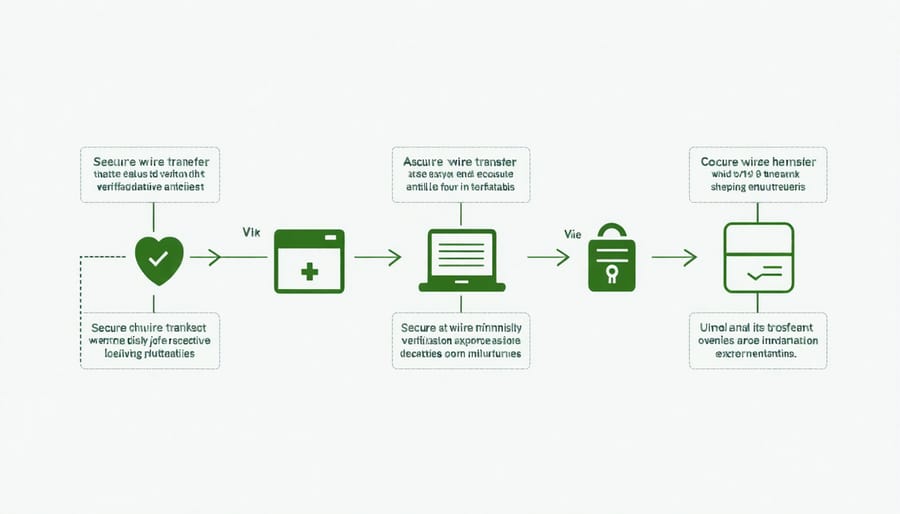Protect your real estate assets by implementing targeted security policies that shield against critical cybersecurity threats and operational vulnerabilities. Modern property management demands layered security approaches, combining digital safeguards with physical protection measures. Issue-specific policies—from access control protocols to data breach response plans—form the backbone of comprehensive real estate security strategies.
Property managers must establish clear, documented procedures for handling sensitive tenant information, maintaining building security systems, and responding to emergency situations. These policies create accountability, ensure regulatory compliance, and protect both physical assets and digital infrastructure. Whether securing cloud-based property management platforms or implementing visitor management protocols, issue-specific policies provide the framework necessary for maintaining operational integrity and protecting stakeholder interests.
By developing targeted security measures that address distinct vulnerabilities, real estate professionals can create robust defense mechanisms that evolve with emerging threats while maintaining operational efficiency. This systematic approach to security policy development ensures comprehensive protection across all aspects of property management and real estate operations.
Digital Property Access Control Policies

Smart Lock and Entry System Protocols
Modern smart home security systems require robust protocols to ensure continuous protection, even during system failures. Property managers should implement a three-tier backup system: primary electronic access, mechanical key override, and emergency response protocols.
For primary electronic access, establish unique access codes for each resident or staff member, maintaining a detailed log of all entries. Program the system to automatically notify designated personnel of unsuccessful entry attempts or power failures. Consider implementing biometric authentication for high-security areas.
Mechanical backup systems should include commercial-grade deadbolts with restricted key duplication. Store backup keys in a secured location, accessible only to authorized personnel. Maintain detailed documentation of key assignments and implement a strict sign-out procedure for temporary access.
Emergency protocols should outline specific procedures for different failure scenarios:
– Power outages: Ensure backup battery systems are regularly tested and maintained
– Network connectivity issues: Install local backup servers for temporary offline operation
– Hardware malfunctions: Maintain relationships with qualified technicians for rapid response
– System breaches: Establish clear notification procedures and immediate lockdown protocols
Regular system testing should be conducted monthly, with comprehensive audits quarterly. Document all tests, maintenance, and incidents in a secure digital log. Update access credentials immediately following staff changes or security incidents, and conduct periodic security awareness training for all users.
Remote Monitoring System Safeguards
A robust remote monitoring system requires clear policies and contingency plans to maintain property security even during system failures. Start by establishing a primary and backup monitoring center, each capable of taking full control during emergencies. Implement a “fail-safe” protocol where all access points automatically lock down if monitoring systems lose connection for more than a predetermined period.
Regular system testing should occur at least monthly, with comprehensive maintenance checks quarterly. Document all test results and maintain detailed logs of any system interruptions or anomalies. Create an escalation matrix that clearly defines who to contact and what actions to take based on the severity of the system failure.
Install backup power supplies with automatic switchover capabilities to maintain surveillance during power outages. Ensure all cameras and sensors have local storage capabilities that can record and store data for at least 72 hours if network connectivity is lost.
Develop and maintain an updated contact list of security personnel, system vendors, and emergency responders. Train all relevant staff on manual security procedures to implement during system downtime. Consider incorporating redundant communication channels, such as cellular backup for internet-based systems.
Set up automated alerts that notify key personnel of any system disruptions via multiple channels (email, SMS, phone calls). Regularly review and update these safeguards to address emerging threats and technological advances in security systems.
Financial Transaction Security Policies
Payment Processing Failure Protection
In today’s digital real estate transactions, robust payment processing failure protection policies are essential for safeguarding both financial assets and sensitive client data. These policies should incorporate comprehensive cybersecurity safeguards for financial transactions while establishing clear protocols for system outages and data breaches.
A well-structured payment processing policy should include redundant payment systems, ensuring that if one processing method fails, alternate secure channels are immediately available. This might involve maintaining relationships with multiple payment processors or having offline payment options ready for emergency situations.
Real estate professionals should implement a three-tier protection approach:
1. Prevention protocols, including regular system testing and updates
2. Real-time monitoring systems to detect potential failures
3. Recovery procedures for immediate response to processing interruptions
Data protection measures must be integrated into these policies, ensuring compliance with financial regulations while protecting sensitive payment information. This includes encryption of payment data, secure storage protocols, and strict access controls for staff handling financial transactions.
Key elements of an effective policy should address:
– Immediate notification procedures for system outages
– Temporary payment processing alternatives
– Client data protection during system failures
– Recovery time objectives
– Documentation requirements for failed transactions
– Clear communication protocols with clients and stakeholders
Regular staff training on these procedures is crucial, ensuring everyone understands their role during payment processing disruptions. The policy should be reviewed quarterly and updated to address new threats or system vulnerabilities, maintaining the highest level of protection for your real estate transactions.
Wire Transfer Security Protocols
Wire transfer fraud has become increasingly prevalent in real estate transactions, making robust security protocols essential. To protect all parties involved, implementing a comprehensive set of verification procedures and safeguards is crucial.
First and foremost, establish a strict verification process for all wire transfer instructions. This includes requiring multiple forms of authentication before processing any transfer requests. Real estate professionals should verify wire instructions through two separate communication channels, such as a phone call followed by an encrypted email confirmation.
Never accept changes to wire instructions via email alone. Instead, implement a callback verification system where designated staff members contact previously verified phone numbers to confirm any modification requests. This simple step can prevent countless fraudulent attempts to redirect funds.
Create a documented chain of custody for wire transfer information. All parties involved in the transaction should maintain detailed records of when and how wire instructions were communicated, including timestamps and verification methods used. This documentation proves invaluable if disputes arise later.
Institute mandatory training for all staff members handling wire transfers. This training should cover common fraud schemes, red flags to watch for, and proper verification procedures. Regular updates to these training sessions ensure teams stay current with evolving threats.
Consider implementing secure communication platforms specifically designed for real estate transactions. These platforms offer encrypted messaging and built-in verification tools that add an extra layer of security to wire transfer communications.
Finally, establish clear procedures for handling suspected fraud attempts. This includes maintaining an updated contact list for banks, law enforcement, and cybersecurity teams who can respond quickly if suspicious activity is detected. Quick action can often prevent or minimize financial losses in wire fraud attempts.

Document Management Security Policies

Cloud Storage Backup Requirements
In today’s digital real estate landscape, maintaining secure backups of critical documents like property contracts, lease agreements, and financial records is non-negotiable. Your cloud storage backup policy should mandate daily automated backups of all essential files, with redundant storage across multiple geographic locations to protect against regional disasters.
Implement a minimum 256-bit encryption standard for all stored data, and require multi-factor authentication for access to backup systems. Your policy should specify retention periods – typically 7 years for financial records and permanent retention for property deeds and critical legal documents.
Set clear guidelines for testing backup restoration procedures quarterly, ensuring your team can recover vital information when needed. Define roles and responsibilities for backup management, including a designated backup administrator and alternate contact for emergency situations.
Your policy should address versioning requirements, maintaining at least three previous versions of critical documents to protect against accidental changes or deletions. Include specific procedures for documenting any backup failures or restoration attempts, with mandatory reporting to management within 24 hours of any significant incidents.
Establish protocols for secure disposal of outdated backups, particularly those containing sensitive client information or financial data. Regular staff training on backup procedures and security protocols should be mandatory, with documented completion records maintained for compliance purposes.
Digital Signature System Protocols
Digital signature systems in real estate transactions require robust security protocols to ensure the authenticity and integrity of electronic documents. These protocols typically include multi-factor authentication, requiring users to verify their identity through a combination of passwords, biometric data, or one-time codes sent to registered devices.
A comprehensive digital signature policy should establish clear guidelines for signature creation, validation, and storage. This includes maintaining detailed audit trails that track when documents are signed, who signed them, and any modifications made to the documents. The system must use industry-standard encryption methods, preferably with a minimum of 256-bit encryption, to protect signatures and documents during transmission and storage.
For real estate professionals, the policy should specify authorized signatories and their permission levels within the system. It’s essential to implement regular user access reviews and immediately revoke access when team members leave the organization. The policy should also outline procedures for signature verification, including steps to validate the authenticity of digital certificates and time stamps.
Document retention requirements must align with local real estate regulations, typically requiring secure storage for at least seven years. Regular system backups and redundancy measures ensure that signed documents remain accessible even in the event of technical failures. The policy should also include provisions for periodic security assessments and updates to maintain compliance with evolving digital signature laws and industry standards.
Insurance Coverage Requirements
Cyber Insurance Specifications
In today’s digital landscape, comprehensive cyber insurance coverage is essential for real estate operations. A robust policy should include minimum coverage of $1 million for data breaches and cyber incidents, with specific provisions for ransomware attacks and business interruption losses. Key coverage requirements typically include first-party losses (direct costs to your business) and third-party losses (claims from affected clients or partners).
Essential coverage types should encompass network security liability, privacy liability, and regulatory defense costs. The policy must specifically address risks related to property management software, smart home systems, and digital payment platforms. Coverage should extend to incident response costs, including forensic investigations, legal consultations, and mandatory breach notifications.
Business interruption coverage should provide at least 30 days of income protection following a cyber incident. Additional specifications include coverage for social engineering fraud, particularly relevant for real estate transactions, and cyber extortion protection with crisis management services. Regular policy reviews are necessary to ensure coverage aligns with evolving digital threats and new property technology implementations.
Deductibles should be set at manageable levels, typically between $10,000 and $25,000, depending on the organization’s size and risk profile.
Property Protection Coverage
Property protection coverage ensures financial safeguards against physical security system failures, including malfunctioning alarm systems, surveillance equipment breakdowns, and access control disruptions. This essential insurance component typically covers both immediate repair costs and potential losses resulting from security breaches during system downtime.
A comprehensive policy should include coverage for equipment replacement, emergency security personnel deployment, and liability protection for incidents occurring during system failures. Property owners should maintain coverage that accounts for at least 80% of their security system’s total value, with additional provisions for business interruption losses.
Key areas to consider include coverage for:
– Electronic security system components
– Backup power systems
– Emergency response services
– Temporary security measures
– Data loss from security system failures
– Third-party liability claims
Insurance providers typically require regular maintenance records and compliance with manufacturer specifications to maintain coverage validity. Property owners should review their policies annually to ensure coverage limits align with current security system values and potential risks. Many insurers also offer premium discounts for properties with redundant security systems or backup protocols in place.
Remember to document all security system maintenance, upgrades, and incidents to support potential claims and maintain favorable coverage terms.
Implementing effective issue-specific security policies requires a strategic approach that balances comprehensive protection with practical execution. Property managers and real estate professionals must prioritize the development of clear, actionable policies that address digital security, physical access control, and financial protection measures.
Success in policy implementation hinges on three key factors: thorough documentation, consistent staff training, and regular policy reviews. Each security policy should clearly outline responsibilities, procedures, and consequences for non-compliance while remaining flexible enough to adapt to emerging threats and changing business needs.
Remember that effective policies must be living documents that evolve with your organization. Schedule quarterly reviews to assess policy effectiveness and make necessary adjustments based on real-world performance and emerging security challenges. Ensure all stakeholders understand their roles in maintaining security protocols and have access to necessary resources and training materials.
For optimal results, integrate your security policies with broader risk management strategies. This includes maintaining detailed incident response plans, establishing clear communication channels, and creating backup procedures for critical systems. Consider implementing a phased approach to policy rollout, allowing time for staff adaptation and system testing.
Finally, document all security incidents and policy responses to build a knowledge base for future improvements. This data-driven approach helps refine policies over time and demonstrates the value of security investments to stakeholders and insurance providers.